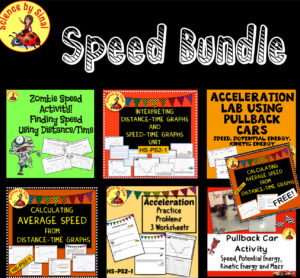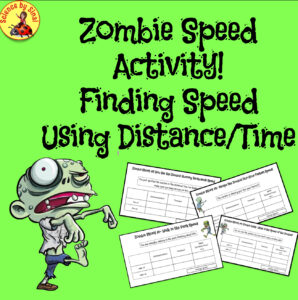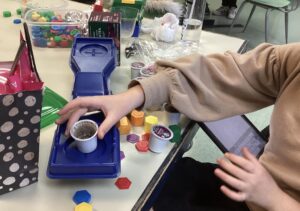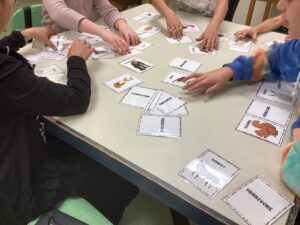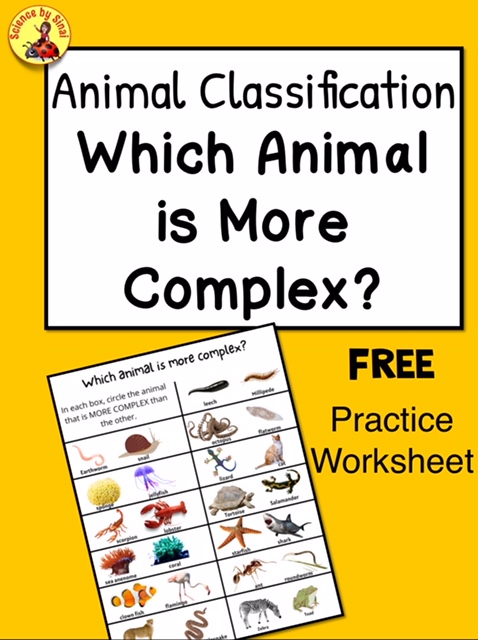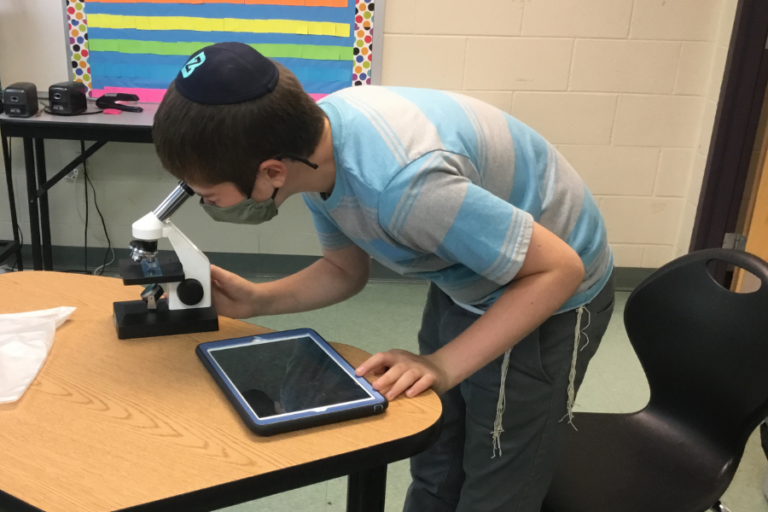How to Overcome Math Phobia in Science Class!
Do your students have math phobia? When you’re introducing an equation or a calculation, in science class, do they freeze up? Are students having trouble applying what they are learning in math class to your science class?

How to Overcome Math Phobia in Science Class!
Updated October 22, 2022
Many students, who love science, are not so fond of the math components when you introduce equations such as density, speed, F=MA, acceleration, etc. The anxiety and reluctance kicks in and science isn’t as fun for them anymore.
The secret to getting students less apprehensive about math is to make it fun and LOGICAL!
Math is the Language of Science
It’s important that we make the students understand that math is just a tool to help us figure things out in science. I think our problem is that math is presented in a classroom, isolated from other topics, without being applied to real life situations. We need to teach the students how to apply their knowledge to prevent math phobia.
Take the Stress Out of Using Math
One of the biggest things that helps calm down my math phobic students is allowing the use of calculators! I tell them that I am teaching science, and how to USE math, not how to COMPUTE math. Of course, we know that’s not completely the truth, but it does a lot towards calming them.
Computing is important but, let’s face it, for the rest of their lives, they will always have a calculator at their disposal. As long as they understand HOW and WHEN to use math, they will succeed.
Make Math Apply to Real Life
I recently had the students count their heartbeats for ten seconds, and then multiply their results by six to solve for beats per minute. As soon as the simple calculation was introduced, I had the math phobia show up. The most important strategy is for students to understand the LOGIC behind the math plus the REASON for the math. Help them get excited about the interesting results that they will get from the data, rather than just treating it like a bunch of word problems in math class.
Have students find their resting heartbeat, after doing jumping jacks or running up two flights of steps. They become eager to see the difference since they can feel their hearts pounding in their chests. They become invested in what the actual numbers reflect!
Use a Hook Before Giving Over Formulas
Introducing density with the formula first, with some practice problems, is sure to trigger any student with math phobia! It certainly happened to me when I was in middle schooI. I had a unforgiving math teacher that made me very mathematically insecure. As soon as numbers came into science class, I went into a panic.
My history of math phobia made me start my unit on density with a different approach. First, we complete a unit on the mass of liquids and different ways to find volume. Then we make a liquid “density tower”, with no mention of the word density. I give them three liquids (blue colored water, red colored rubbing alcohol and plain vegetable oil) and ask students to layer the liquids in the order of red, white and blue.
Students may have heard of density in the past, but it is not until after we have layered the liquids successfully, that we start asking WHY does this work?
We still don’t use the word density yet but we find the mass and volume of each one of the liquids. I put the density= mass/volume equation on the board and ask students how it may help. It doesn’t feel too threatening and I ask them to look for a pattern.
After calculating the density of the three liquids, they will come to the conclusion that the densest liquid went to the bottom of the test tube and the least densest was at the top. Now we can define density and talk about the different aspects. See that? The math has become secondary to the idea of the “trick” of making liquids layer and creating a cool page in their digital science notebooks!
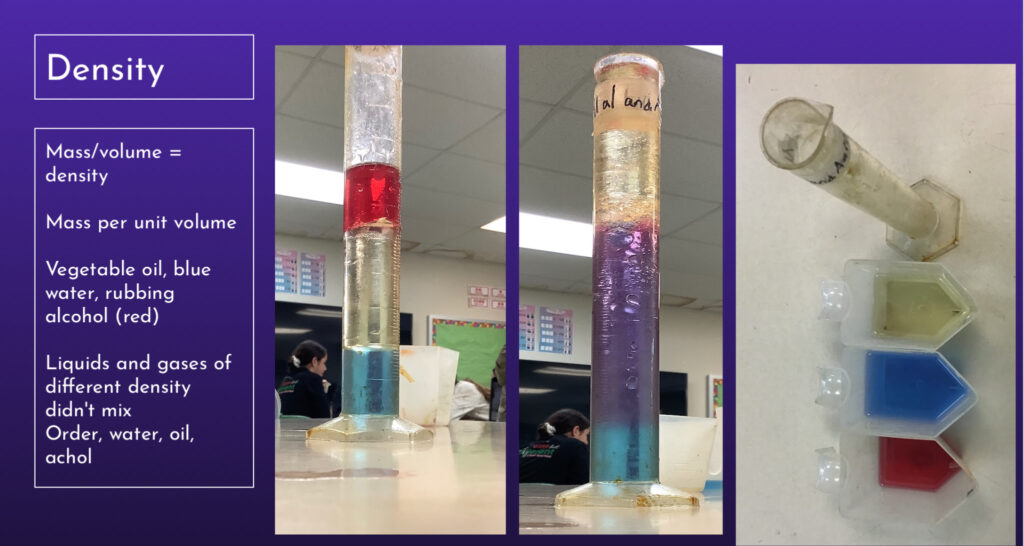
Why Was I Never Taught the “Magic Triangle”?
Many of you are familiar with a magic triangle but I was never taught this method until college! It would’ve made my life so much easier! I like to print out big versions of the triangle and have students put their hands down on which aspect they are solving.
For example, the density triangle has mass at the top and density and volume at the bottom. If the students are given the density and volume, and want to solve for mass, they put their hand over the “M” and look what the triangle tells them to do. In this case, they would multiply the density times volume to find the mass. We do this over and over again before we even try to do one problem.
Gather Data and Then Use Logical Math
Finding speed using speed =distance/time is another equation that I introduce AFTER we have done an activity to gather data. We go outside and turn into zombies!
We pretend that we’re walking through a park at a casual pace and, after we have measured a specific distance, we use a stopwatch to measure the time it took to go that distance. At this point, students only have a data chart and don’t do any final math. They then pretend that they saw the zombie and record their panicked RUN! Finally, they actually turn into zombies and do funky zombie walks!
It’s not until we get inside, and we start analyzing the numbers, that students realize that distance divided by time will give us our speed. They have all heard of miles per hour. That actually means miles divided by hour. We transfer that knowledge to meters per second. Using the magic triangle, we can start solving for time or distance. (Distance is on the top of the triangle and speed and time are at the bottom). We can keep referring back to the zombie activity, through our motion unit, which keeps it lighthearted and not so threatening.
Layer Student’s Knowledge for Math Retention
After the zombie lab, we can then play with pullback cars on the floor of my classroom. Again, we work with data charts first and THEN deal with the number crunching for deeper understanding and less stress.
When learning about potential energy versus kinetic energy, we pull the pullback cars backwards, with varying distances, to see if it affects the speed of the cars. Students need to measure the starting line, finish line, find the mass of the car, solve for speed and then find averages. All in one lab! Then we tape some more mass onto the roofs of the cars and do the lab all over again. They also graph their information for a visual analysis. By the time they are done this lab, they have a good working knowledge of the math involved and it was fun!
I am then able to move onto acceleration of the pullback cars, which has a more complex formula of final speed minus initial speed divided by time.(Make Speed and Acceleration Labs Fun with Pullback Cars!) However, the students are much calmer because they have already dealt with the speed formula over and over again.
As we continue the layering of math skills, we move onto looking at distance-time graphs or speed-time graphs and learning how to interpret them. We can refer back to the zombies to try to find the average speed, using graphs, as well.
Students May Not Have Had the Necessary Math Yet in Their Math Class
Occasionally I want to do an activity using math that the students haven’t experienced in math class yet. Again, I like to do the activity and then have the students understand that, in order for us to analyze our results, we need to do a special type of math.
One of the labs that I do with my sixth graders, during our environmental unit, is to find out what percent of a packaged product is actually trash that will go to a landfill. Learning percentages does not always equate with the math curriculum of 6th grade, so I am sometimes teaching it for the first time.
We ask the question about a packaged product as to HOW MUCH of the package actually ends up in the trash truck? The students become very curious since they brought the packages in from home to measure. After we recognize that we are finding the “piece of the whole”, the math of finding percentages makes more sense to them.
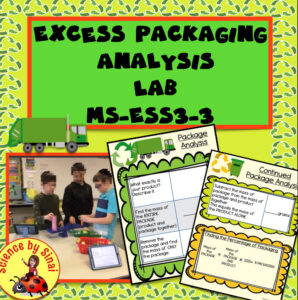
Conclusion
Math phobia can be crippling and prevent forward motion in terms of learning. It is not something to be taken lightly and we need to respect our students who have different degrees of this condition.
I have found that making the activities meaningful and logical helps tremendously. Being honest about my own phobia, at their age, really makes them feel much more comfortable. After speaking to other teachers, I know I’m not alone with my past experiences.
As stated above, we need to make sure that the students understand that math is the language of science. It helps us understand and interpret the data that we are gathering so that we can learn the overall concepts.
